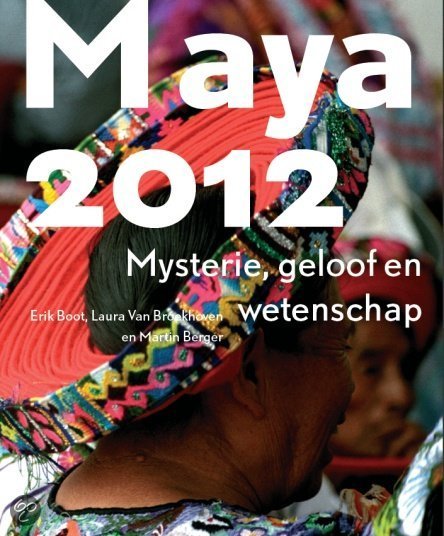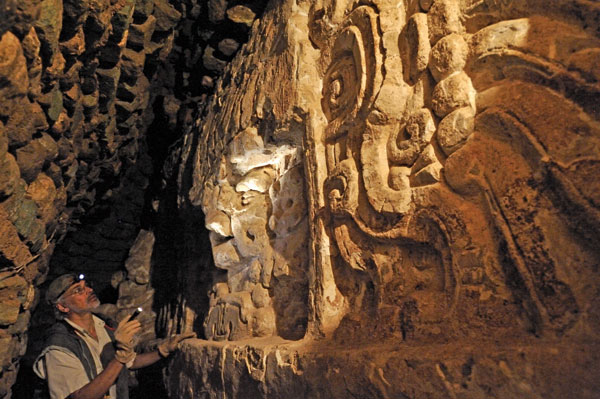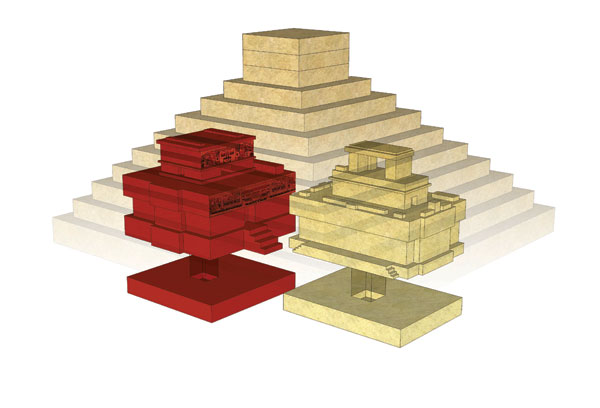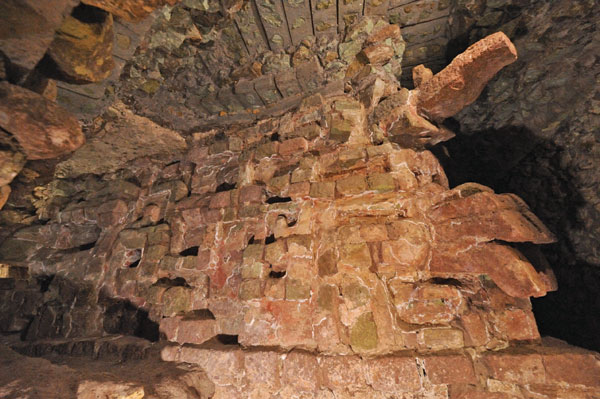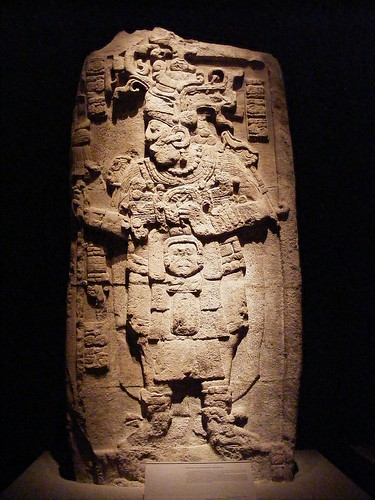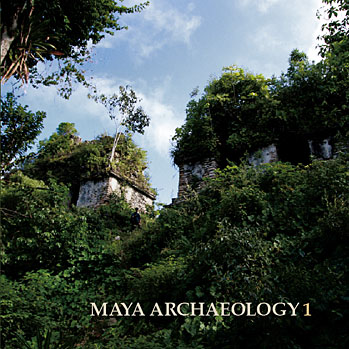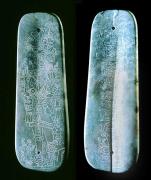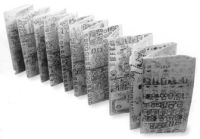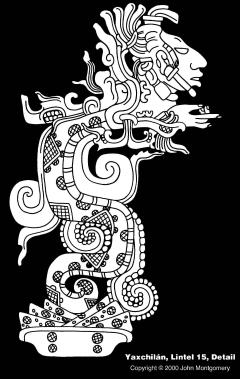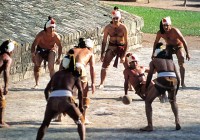Maya News Updates 2008, No. 28: Copan, Honduras - Largest Jade Object Ever Found Excavated At Copan
According to archaeologists working at Copan they have excavated the largest jade object ever encountered at a Maya site. The object was found in the Oropendola structure, located within Temple 10L-16 at Copan, as reported today, Sunday May 18, 2008, by the online edition of the daily Meican newspaper La Jornada (edited by MNU):
Hallan en Copán la pieza de jade más grande - Arqueólogos hondureños encontraron en el Parque de Copán, unos 500 kilómetros al occidente de esta capital, lo que es hasta el momento la pieza de jade más grande que se haya descubierto en los países del Mundo Maya.
Así lo dio a conocer el ministro de Turismo de Honduras, Ricardo Martínez, al inaugurar ayer aquí el quinto Congreso Nacional de Turismo, al que asisten el ministro de Turismo de Cuba, Alex Trujillo, y el director general del Consejo de Promoción Turística de México, Oscar Fitch. El funcionario explicó que la pieza fue encontrada en fecha reciente al realizarse excavaciones en el templo Oropéndola, en el Parque de Copán, el principal centro arqueológico maya que tiene Honduras.
“En ese lugar se encontró una pieza de jade del tamaño de una pelota de futbol, la más grande descubierta en los países del Mundo Maya’, precisó al referirse al circuito cultural conformado por México, Guatemala, Honduras, El Salvador y Belice. El hallazgo todavía no se ha divulgado en sus detalles y todo indica que lo que se ha encontrado en las excavaciones es una tumba real en Oropéndola, en momentos en que el arqueólogo hondureño Ricardo Agurcia realiza trabajos de reforzamiento en los túneles de ese centro (Notimex; source La Jornada).
Important discoveries at the Oropendola structure at Copan were presented earlier this year by archaeologist Dr. Ricardo Agurcia, as reported by the online edition of the daily Honduran newspaper HonduDiario on April 6, 2008 (edited by MNU):
Templo Oropéndola un tesoro de Copán Ruinas - Un lugar impregnado de riquezas la mayoría bellísimas piezas de jade que para los mayas era más valioso que el oro se encuentran enterradas en el último templo descubierto en la acrópolis de Copán Ruinas denominado Oropéndola.
El aposento que se encuentra enterrado en la estructura 16, justamente enfrente del Templo Rosalila mide unos 18 metros, está construido de estuco modelado y posee las primeras esculturas en piedra de la prehispánica ciudad, factor que le da más importancia a la edificación. Según el arqueólogo Ricardo Agurcia, Oropéndola fue edificada entre el 600 a 700 después de Cristo y en el se observa la tradición más importante de piedra tallada. Valiosísimas piezas de jade, conchas y otros materiales que simbolizan el inframundo, entre los que destacan unos grafitis extraordinarios que hasta ahora se exhiben han sido sacadas del sitio de excavación y son exhibidas en el Centro Regional de Investigaciones Arqueológicas (CRIA) en Copán Ruinas.
“Oropéndola es muy diferente al famoso Templo Rosalila en su interior, además es nueve por ciento más extenso y posee una colección de riquezas pertenecientes a emperadores Mayas”, aseguró Agurcia quien es el responsable del descubrimiento del lugar que para los Mayas era sagrado. La orientación de los cuatro cuartos que forman la edificación está ubicada en cruz y la pieza más artística en el este, la más extensa en el oeste, mientras al sur la vista es impresionante y al norte asemeja a una elaboración con madera.
Según el experto, esa forma de situar las piezas en cruz y en las cinco direcciones cardinales significa para los Mayas el universo que como buenos astrónomos tomaban en cuenta en todos los aspectos de su vida. Oropéndola fue descubierto hace siete años, pero los trabajos de excavación iniciaron en el 2007 cuando se dio a conocer su existencia ante los medios de comunicación. Por los momentos ya se ha avanzado en su revelación y es poco lo que falta por descubrir, pero no esta habilitado para el turista debido a que por ahora se trabaja en la investigación de sus secretos (written by Lesly Vásquez; source HonduDiario).
El aposento que se encuentra enterrado en la estructura 16, justamente enfrente del Templo Rosalila mide unos 18 metros, está construido de estuco modelado y posee las primeras esculturas en piedra de la prehispánica ciudad, factor que le da más importancia a la edificación. Según el arqueólogo Ricardo Agurcia, Oropéndola fue edificada entre el 600 a 700 después de Cristo y en el se observa la tradición más importante de piedra tallada. Valiosísimas piezas de jade, conchas y otros materiales que simbolizan el inframundo, entre los que destacan unos grafitis extraordinarios que hasta ahora se exhiben han sido sacadas del sitio de excavación y son exhibidas en el Centro Regional de Investigaciones Arqueológicas (CRIA) en Copán Ruinas.
“Oropéndola es muy diferente al famoso Templo Rosalila en su interior, además es nueve por ciento más extenso y posee una colección de riquezas pertenecientes a emperadores Mayas”, aseguró Agurcia quien es el responsable del descubrimiento del lugar que para los Mayas era sagrado. La orientación de los cuatro cuartos que forman la edificación está ubicada en cruz y la pieza más artística en el este, la más extensa en el oeste, mientras al sur la vista es impresionante y al norte asemeja a una elaboración con madera.
Según el experto, esa forma de situar las piezas en cruz y en las cinco direcciones cardinales significa para los Mayas el universo que como buenos astrónomos tomaban en cuenta en todos los aspectos de su vida. Oropéndola fue descubierto hace siete años, pero los trabajos de excavación iniciaron en el 2007 cuando se dio a conocer su existencia ante los medios de comunicación. Por los momentos ya se ha avanzado en su revelación y es poco lo que falta por descubrir, pero no esta habilitado para el turista debido a que por ahora se trabaja en la investigación de sus secretos (written by Lesly Vásquez; source HonduDiario).




